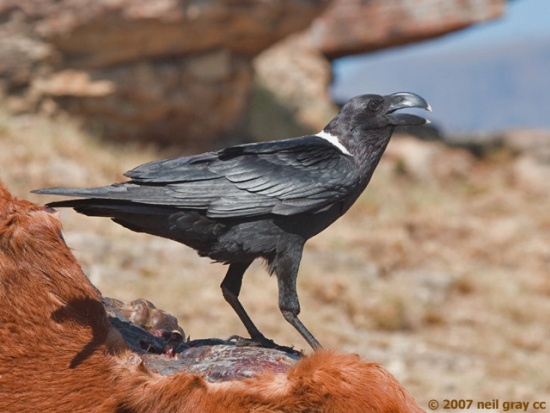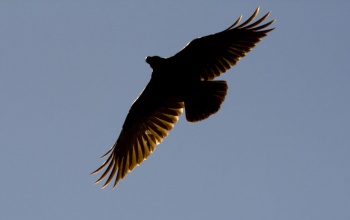(Dictionary & Video links. References updated) |
(→Taxonomy: Update link) |
||
| Line 18: | Line 18: | ||
Locally common and in some parts of distribution regarded as pest because of it's sheep-killing habits. | Locally common and in some parts of distribution regarded as pest because of it's sheep-killing habits. | ||
==Taxonomy== | ==Taxonomy== | ||
| − | This is a [[Dictionary_M- | + | This is a [[Dictionary_M-O#M|monotypic]] species<sup>[[#References|[1]]]</sup>. |
Forms a species pair with [[Thick-billed Raven]] and with the latter sometimes placed in genus ''[[:Category:Corvultur|Corvultur]]''. | Forms a species pair with [[Thick-billed Raven]] and with the latter sometimes placed in genus ''[[:Category:Corvultur|Corvultur]]''. | ||
| + | |||
==Habitat== | ==Habitat== | ||
Small towns and villages with nearby mountains or hills for roosting.<br /> | Small towns and villages with nearby mountains or hills for roosting.<br /> | ||
Revision as of 22:21, 4 July 2014
- Corvus albicollis
Identification
50 - 56cm. A large, unmistakable raven:
- Short tail and broad-based wings
- Plumage mainly black
- Black-brown throat, blackish-brown breast and neck with faint purple gloss
- Large patch of white feathers on the back of the lower neck
- Deep, arched bill with white tip
Sexes similar. Juveniles with all black bill and duller than adult.
Distribution
Southern and eastern Africa.
Found from Uganda and western Kenya south to Democratic Republic of Congo, Rwanda, Burundi, Tanzania, Zambia, Malawi, Mozambique, Zimbabwe, South Africa, Swaziland and Lesotho.
Vagrants recorded in Botswana, Namibia and Sudan.
Locally common and in some parts of distribution regarded as pest because of it's sheep-killing habits.
Taxonomy
This is a monotypic species[1].
Forms a species pair with Thick-billed Raven and with the latter sometimes placed in genus Corvultur.
Habitat
Small towns and villages with nearby mountains or hills for roosting.
Mostly recorded between 1000 and 3000m, locally higher.
Behaviour
They spend much of the day thermalling high, often with vultures. Usually foraging alone or in pairs.
Diet
The diet includes carrion from road kills, fruit, grain, insects, small reptiles, peanuts and human food. Robs bird nests (even of Verreaux's Eagle) and kills sickly newborn lambs.
Breeding
Nests are mainly on a cliff ledge but will occasionally nest in a tree. The clutch consists of 3-5 egg. A monogamous species, with long-term pair-bond.
Movements
A sedentary species but large flocks of non-breeders wander around in non-breeding season.
References
- Clements, J. F., T. S. Schulenberg, M. J. Iliff, B.L. Sullivan, C. L. Wood, and D. Roberson. 2013. The eBird/Clements checklist of birds of the world: Version 6.8., with updates to August 2013. Downloaded from http://www.birds.cornell.edu/clementschecklist/download/
- Del Hoyo, J, A Elliott, and D Christie, eds. 2009. Handbook of the Birds of the World. Volume 14: Bush-shrikes to Old World Sparrows. Barcelona: Lynx Edicions. ISBN 978-8496553507
Recommended Citation
- BirdForum Opus contributors. (2024) White-necked Raven. In: BirdForum, the forum for wild birds and birding. Retrieved 23 April 2024 from https://www.birdforum.net/opus/White-necked_Raven
External Links





